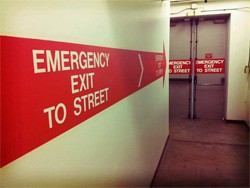
Our Community
Pauline Vela is the Network Services Manager at Tides. This post is in commemoration of the UN International Day for Disaster Reduction, October 13.
 In 2011 alone, the US has witnessed more than its fair share of natural disasters, from blizzards to heat waves, wild fires, the unexpected earthquake that rocked Virginia, and most recently, the flooding and damage wreaked by Hurricane Irene. For those of us who have escaped or survived disaster, we are hopefully reminded that it’s time to get our act together and prepare for emergency situations. And yet, it can be difficult to act on our best intentions. Even for those of us who have taken precautions, we should ask, “How prepared are we?” Though we can never be completely prepared, every little bit helps and some simple steps can put ourselves—and our organizations—in a much better position than no preparedness at all.
In 2011 alone, the US has witnessed more than its fair share of natural disasters, from blizzards to heat waves, wild fires, the unexpected earthquake that rocked Virginia, and most recently, the flooding and damage wreaked by Hurricane Irene. For those of us who have escaped or survived disaster, we are hopefully reminded that it’s time to get our act together and prepare for emergency situations. And yet, it can be difficult to act on our best intentions. Even for those of us who have taken precautions, we should ask, “How prepared are we?” Though we can never be completely prepared, every little bit helps and some simple steps can put ourselves—and our organizations—in a much better position than no preparedness at all.
Here at Tides, we take emergency preparedness seriously because we know that in order to best serve our clients and our communities, we also need to take care of our staff. In our San Francisco office, we have a Safety Team composed of twelve captains, each of whom is assigned a group of 12-14 people that they need to account for in an emergency situation. All captains are Neighborhood Emergency Response Team (NERT) certified and also have certification in First Aid and CPR. In addition, we have five emergency disaster kits strategically placed throughout the office, containing items like flashlights, first aid kits, enough food to last 72 hours, blankets, and the like.
But Tides is just one example and it is always a work in progress. Your organization’s needs, capacity, and resources should determine your plan.
There are a number of resources that can help us all with the work of being prepared – here are a few good places to start:
And of course, you’ll want to prepare for emergencies at home and in your car as well!
Having an emergency preparedness plan is not an option, it is a necessity. Every organization, every family, and every individual should have one.
Image via Flickr user Markus Spiering, used under Creative Commons license.

Read the stories and hear the voices of social change leaders fighting for justice.